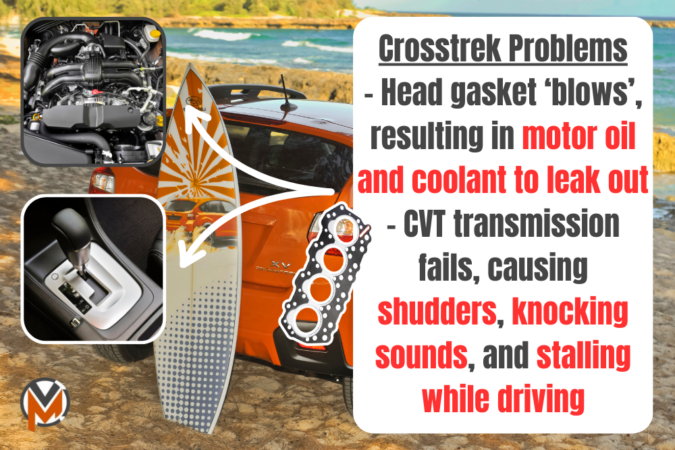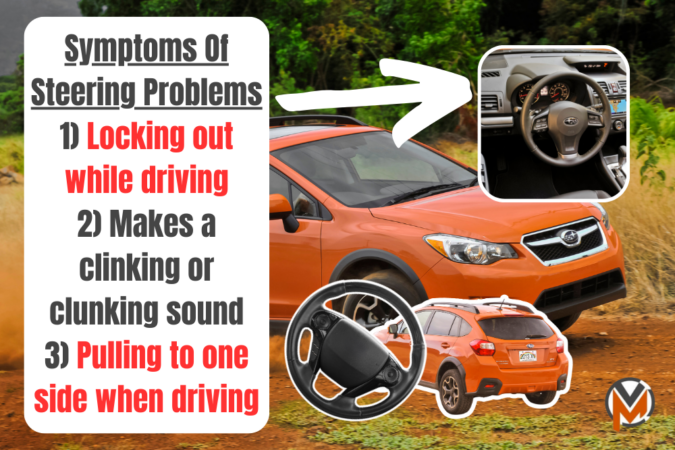Subaru is a brand well-known for its tough, dependable cars. But, no car is ever perfect, and even some of Subaru’s more reliable models, like the Subaru Crosstrek, have their fair share of problems. Some of the more common issues you might encounter on the Crosstrekinclude excessive oil consumption, head gasket faults, as well as CVT transmission failures.
To be fair, there was nothing fundamentally wrong with the Subaru Crosstrek, as it was built on the same, proven platform as the Impreza. This meant it adopted tried and tested mechanics, though it was plagued with sporadic problems. With that being said, continuous improvements and gradual evolution have made the Crosstrek a pretty reliable option nowadays.
Common Problems With The Subaru Crosstrek
If you’re looking to get a used Subaru Crosstrek, here are some of the most common Subaru Crosstrek problems that you need to look out for:
1. Head Gasket Failure
This is by far the most common of all Subaru Crosstrek problems; the head gaskets. In fact, faulty head gaskets are one issue that many Subaru models face, despite their reputation for being generally reliable. This head gasket issue is more prevalent on the larger 2.5-liter engine. The head gasket is responsible for proper motor oil and coolant flow.
When the head gasket “blows”, motor oil and coolant can leak out, thus overheating the engine and damaging the internals. As you can imagine, this is pretty damaging, and replacing the head gasket involves disassembling most of the entire engine. If the head gasket does blow, among the symptoms you’ll experience is likely to be engine overheating.
Otherwise, you might also notice white smoke coming out of your exhaust. If and when you do notice these symptoms, it’s vital to be diligent and get this fixed ASAP. Otherwise, continuing to drive with a worn head gasket could end up mortally damaging the engine. Unfortunately, the cost of replacing the head gasket, given its complexity, is pretty costly.
A head gasket replacement can cost upwards of $1,500 just for labor alone. The parts cost will add in another $1,100 to $1,200 just for the gasket and an additional $700 for other associated parts. Nevertheless, this is way cheaper than having to replace your Crosstrek’s entire engine, which is what would happen if you ignore a head gasket failure.
2. CVT Transmission Failure
In 2018, Subaru announced a warranty extension program for its Continuously Variable Transmissions (CVTs), including the one used in the Crosstrek. This hiked the warranty for the transmission from the original 5 years or 50,000 miles to 10 years or 100,000 miles, whichever comes first. This extension applied to almost all of their models in the US.
That includes the Crosstrek, Legacy, Forester, Impreza, WRX, and Outback. Subaru claims that there were no customer complaints or concerns raised against the CVT. The warranty extension was more of an added assurance about the reliability of the CVT, they reported. However, customers had a different story, detailing countless issues with Subaru’s CVT.
According to Subarucomplaints.com, almost 1,500 individual complaints were logged in and reported connection with this issue. Customers experienced odd shudders and vibrations, stalling or their cars dying out while driving, and knocks from the CVT. In short, the CVT started to give a jarring ride, a few years into the life of the vehicle.
Under this extended warranty for Subaru’s CVT transmission, customers could get free repair and replacement of parts if they were facing problems with their CVTs. Dealers conducted free inspections even for vehicles that did not have any symptoms. Otherwise, if you’d have to pay out of pocket, a brand-new transmission from Subaru would cost $7,000 to $8,000.
3. Excessive Motor Oil Consumption
This is yet another one of the many Subaru Crosstrek problems that were shared with its sister models. Many Subarus, including the Crosstrek, particularly from the model years 2012 to 2015 were found to have consumed more oil than it is used to. This is among a litany of other Subaru oil consumption issues. Part of this was due to that head gasket issue from earlier.
However, besides the faulty head gasket design, the excessive oil consumption problem was attributed to other causes, too. Subaru dealers were forced to replace pistons and oil rings to bring this issue under control. However, this was found to be only a temporary stop-gap measure. As such, they later decided to replace the entire short block assembly to fix this for good.
4. Faulty PCV Valves
Out of all the common Subaru Crosstrek problems that we mentioned thus far, this one is among the more recent to be found, affecting the second-generation Crosstrek, built after 2018. In particular, the PCV valves were found to be flawed. It keeps the waste gases from building up inside the crankcase. It thus lets gases escape back into the intake system for reuse.
But, with the Crosstrek, the PCV valve can go wrong. If the PCV valve fails, motor oil may enter the combustion chamber. It could get worse, as the parts of a PCV valve can also fall into the engine, damaging the internals. A recall was issued for this problem, covering the costs of replacement. Subaru also offered to cover the cost of replacing the engine.
5. Rodent Infestation On The Wiring
Subaru, in a bid to be as eco-friendly as possible, swapped some of the synthetic plastic electrical wire coatings with greener material. This bio-degradable soy-based coating was great for nature as it reduced the synthetic waste going to landfills. It was also cheaper, helping Subaru save money. However, this had an unintentional side-effect; rodent attacks!
In the eyes of a rat or most other rodents, all those soy-based wiring and cables were large chew toys nestled in a dark, safe environment warmed up by an engine after a drive. Rat heaven maybe. The soy-based wires were chewed on by rodents, leading to electrical issues. Many owners woke up to severed fuel lines or torn-out wiring harnesses.
To be fair, Subaru was not the only manufacturer caught in this mess. Along with Subaru Toyota, Honda, Hyundai, and Kia had lawsuits filed against them. Pretty much most other carmakers adopted the use of soy-based wiring. Owners were also enraged to find out that their warranty did not cover this damage, and the repair bills were pretty significant.
6. Failure Of Subaru Eyesight
Subaru Eyesight is a suite of driver-assist technologies that helps improve safety. It includes active safety systems pre-collision automatic braking, lane-departure alerts, collision warning, and adaptive cruise control. Unfortunately, Subaru’s Eyesight, particularly some of its earlier iterations, wasn’t particularly precise and could be easily distracted.
In fact, Subaru’s Eyesight system could easily be hindered by fog, water spray, and other environmental conditions. To make matters worse, it used monochrome cameras in its earlier versions. This made it difficult for it to spot and recognize brake lights. Thankfully, Subaru swapped it out for color cameras starting in 2015.
7. Steering Issues
The next problem with the Subaru Crosstrek is associated with the car’s steering. Mainly found in the 2016 Subaru Crosstrek, this problem can be a pain to live with. The steering of these vehicles reportedly gets locked while driving or it makes a clicking or clunking noise when turning at full lock. As you can imagine, this is both unsafe and dangerous.
Your Subaru Crosstrek, if it was impacted by these steering problems, may pull to one side while driving. This one is particularly frustrating among the Subaru Crosstrek problems. However, it would not be a massive headache to fix, at least compared to some of the other issues mentioned up above. Still, it’s worth bearing this in mind if you’re getting one.
8. Cracking Windshield
Many reports by owners of Subaru Crosstreks of their windshield cracking have been reported. Oftentimes, these reports were made of their windshield cracking without even an impact. The crack may also spread rapidly across the rest of the windshield. Obviously, the only proper and permanent fix for this issue is to replace the windshield.
Or, if the chips and cracks aren’t significant, you could also get away with repairing the chips or cracks using a DIY repair kit. This particular problem, however, is not rampant or severely fundamental with the Subaru Crosstrek as a whole. Only a few vehicles are found to have developed this issue, but it’s worthwhile taking notes if you’re planning to buy one.



